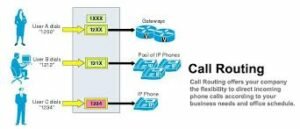
Call Routing strategies have led to a lot of intriguing questions like – How do you transfer your customers’ call to the right person as quickly as possible? How do you take care of the long hold time, customer frustration or defection of your customers to competition? How do you ensure first call resolution?Call routing is an important part of any efficient customer service strategy. By directing calls to the right department on the first go, the level of customer satisfaction increases with overall reduction in the operating cost. However, call routing is considered as a strategic tool in the business environment, if done properly and efficiently.
Call Routing Strategies to Improve Customer Service are as follows ;
Routing By IVR:
Call routing by IVR is among the most common and the most famous routing methods followed by organisations. IVR allows customers to interact with the organisation through telephone keypad or speech interaction. The IVR systems can respond with prerecorded or dynamically generated audio to further direct users on how to proceed for their query. Routing through IVR is most demanded in lead generation businesses and contact centers. This strategy is especially good for lead generation businesses and call centers.
Direct Routing:
Organisations looking towards building direct relationship with customers or having a basic approach to customer service are mostly involved in direct routing strategies. Customers are provided with the direct number of the particular department they intend to call. For example: If a customer wants to speak to the sales department, there is a direct number for the sales department. Likewise, there are different numbers for different departments. This ensures that the first connect is to the right department, thereby welcoming more sales closure and higher success rate. But usually the wait time in this strategy is longer if the agent or the rep is busy on another call.
Skill-Based Routing:
Selecting this strategy for your organisation may save customers from long wait time or frustration during service calls. The customer experience can be improved by matching the highest skilled agent available to handle each call. A successful skills-based routing strategy increases agents’ efficiency by allowing them to use personal knowledge and experience to answer customer’s query. This reduces the average call handling time per agent, leading to higher first call resolution with improved customer satisfaction rate.
Routing by Caller ID:
This routing strategy allows you to put some intelligence in the routing system. The phone numbers of certain customers can be recorded as per the urgency of their subject matter. Each customer can be allotted a unique caller ID. Whenever the customer calls, the call gets automatically routed to the most appropriate agent depending on the last conversation or recorded information in the CRM. For instance, if the contract of a certain customer is expiring; the next time the customer rings the department, the call can will directly land to the agent who specialises in retention of existing customers.
Database Integration Routing:
Service calls are very crucial when it comes to retaining customers. By integrating the call routing with the customer database, agents can easily look up at the history of the previous conversations and can accordingly take smart and useful decisions. For example: if the caller is an existing customer, route the call to the support department. If the caller is a new customer, route the call to the inquiry or sales department.
Business Rules Routing:
Keeping specific business objectives in mind, organisations can align their routing strategies with their business goals. Once the ACD and other applications are in place, organisations can use their routing strategy to their specific business needs. For instance, customers with higher value can be routed to a premier agent. Accordingly, a frustrated or an angry customer attempting to discontinue the usage of a particular service can be transferred to the retention department. Obviously, the strategy being used overe here depends on the specific business goals.
Multimedia and multi model routing:
Being consumers, we interact through various channels with our different suppliers. Some suppliers respond perfectly at a particular channel and some do not. The critical routing challenge many organisations now face is how to route multimedia transactions across multiple customer contact channels. The situation gets worse when multimedia extends its capabilities to multi-modal routing, where a consumer might be calling or texting from a particular device or from a remote location. For eg: Suppose a customer is calling from his ABC phone, the solution has to be process oriented and at the same time the customer ID should be able to map the CRM history of the customer giving each and every detail about the ABC phone helping in the real time decision making. Here, for sure the technology plays an important role but an organisation must keep their resources intact to support such new generation of multimedia and multi modal customer transactions taking place.
Percentage Based Routing:
An efficient call center manager ensures that the workload is fairly distributed among all the agents. The manager can see on his dashboard the total percentage of calls received per agent and then can accordingly design the routing strategy to minimize the long wait times.